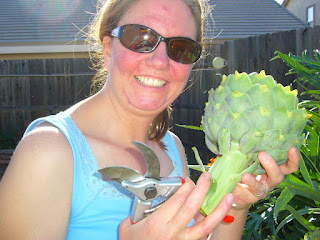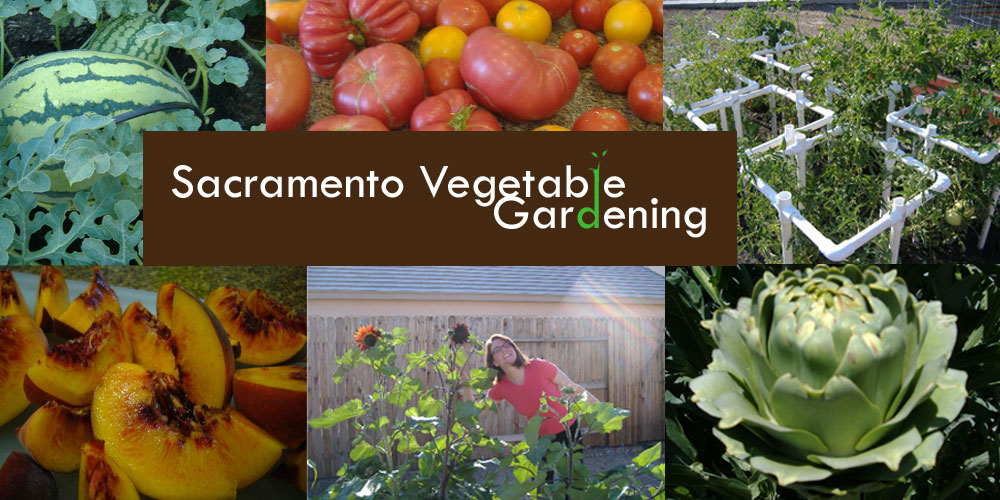 |
| The Wife That is Venus with "Godzilla" |
It's a seminal moment in the world of backyard vegetable garden. One doesn't grow an artichoke the size of the wife's head all that often. Yet that is the "vegetable of the day" that the wife that is Venus is holding. It's the garden payoff after coaxing artichoke monsters to grow into the size of Godzilla-like proportions during the fall, winter and early spring months.
The spring crop has arrived.
Venus and I have been munching on artichokes since harvesting the monster above right last weekend. The blast of warm rain during the week proved to be a welcome event as artichoke plants love cool, rainy weather and suck up the moisture.
 |
| Our Spring Artichoke Crop |
Artichokes are one of those rare, coastal plants that will not only grow in the Sacramento region -- but thrive. The brutal onset of our furnace-like summer conditions ensures we will not get a followup fall crop, but it doesn't matter. By the time spring artichoke season ends? We will have consumed so many of them that just the sight of artichokes will bring on that familiar -- somewhat sick -- feeling.
Artichokes? Again? Really? I'd rather have a serving of frozen cardboard, please.
In other words -- the spring season quenches our artichoke desire just fine. There is no need for a repeat.
 |
| A unique variety: The Pineapple |
Venus and I started growing artichokes when we first ventured into this world of vegetable gardening after the purchase of our first North Natomas spread in 2003. I use the word "spread" somewhat facetiously. Most North Natomas backyards are the size of mere postage stamps.
Why Sacramento City leaders argue against the ills of childhood obesity and then allow the construction of subdivisions with backyards not big enough for kids to skip a rope in is beyond me. Where do you expect them to run off that excess energy? The street?
Sorry -- I allowed myself to enter "rant" stage. Back to the subject: Monster artichokes.
 |
| Standard "Globe" Artichokes |
Artichokes tend to grow rather quickly and will take up all available space. Many people have asked me how much room is needed to grow artichokes? My response is, "how much room do you have?" The point is, artichokes will take up that space and then keep right on growing into that spot you had reserved for azaleas.
In our case? With our smaller than small, postage-stamp sized backyard? We forced our artichoke plants to grow up rather than out. While this effort did work and did produce somewhat of a payoff, it also produced very tall and skinny artichoke plants that would sometimes snap in two due to the weight of the crop it was holding.
 |
| Our Artichoke Patch: One of Two |
It was a sight that would bring tears to your eyes.
Venus and I started with four artichoke starter plants purchased from an Elk Grove nursery that has long since closed. I wish I could tell you the names of these varieties, but I honestly cannot. They were not labeled. We spotted four plants sitting on the corner of a shelf all those years ago and grabbed all four. End of story.
I didn't want to lose those productive varieties when my wonderful wife and I moved into our larger-than-life spread some years later. So, I proceeded to dig up the well developed root systems, stick them in pots, transported them to a new home and stuck them in a raised bed. They didn't so much as blink an eye. New growth emerged from the raised bed almost immediately. Transition = success.
 |
| The Pineapple: Unusual tips |
But it's this very transition that does cause some consternation. These varieties -- which grow to massive sizes -- do not have a name. We call them our pineapple variety due to the well developed tips that appear on each artichoke. They look much like the rind of an pineapple. But this looks like no other variety grown in California -- commercially or in a garden setting.
Most artichoke leaves have a smooth, rounded ends. Some are somewhat sharper than others -- but none have this outlandish tip that is pin-sharp to the touch before cooking and quite soft after 90 minutes of steaming. I suppose it could be a mutation of the standard Globe or Imperial Star, or it could be a very old heirloom variety that has withstood the test of time in many a backyard garden.
 |
| Preparing for Harvest |
No matter. This is our favorite variety for many a reason. The leaves are soft, buttery and tasty after cooking. The hearts are of a massive size -- the big payoff for an artichoke connoisseur. The early season stems are just as tender and flavorful as the heart itself with early season production, but will grow tough and stringy as the weather warms up.
No need to serve this baby with a side of anything other than a mixture of butter and garlic salt. This is a meal in itself.
I should know. I've had a few of them this past week. And a few more are yet to come. Venus and I expanded upon our artichoke experiment a few years ago. Instead of one or two plants, there are now seven or eight. That makes for a tasty crop.
Long live the Pineapple.
MORE ABOUT ARTICHOKES:
Saveur Magazine has a nice listing of artichoke varieties here (no sign of our Pineapple, however).
The Artichoke Advisory Board of California has a listing of commercial varieties here. Can you spot our mystery variety? We can't.

























